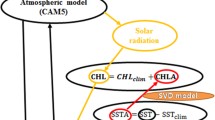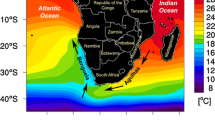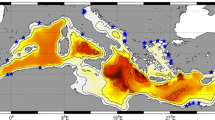Abstract
Climate modeling groups nowadays develop earth system models (ESMs) by incorporating biogeochemical processes in their climate models. The ESMs, however, often show substantial bias in simulated marine biogeochemistry which can potentially introduce an undesirable bias in physical ocean fields through biogeophysical interactions. This study examines how and how much the chlorophyll bias in a state-of-the-art ESM affects the mean and seasonal cycle of tropical Pacific sea-surface temperature (SST). The ESM used in the present study shows a sizeable positive bias in the simulated tropical chlorophyll. We found that the correction of the chlorophyll bias can reduce the ESM’s intrinsic cold SST mean bias in the equatorial Pacific. The biologically-induced cold SST bias is strongly affected by seasonally-dependent air–sea coupling strength. In addition, the correction of chlorophyll bias can improve the annual cycle of SST by up to 25%. This result suggests a possible modeling approach in understanding the two-way interactions between physical and chlorophyll biases by biogeophysical effects.










Similar content being viewed by others
References
Anav A, Friedlingstein P, Kidston M, Bopp L, Ciais P, Cox P, Jones C, Jung M, Myneni R, Zhu Z (2013) Evaluating the land and ocean components of the global carbon cycle in the CMIP5 earth system models. J Clim 26:6801–6843
Anderson JL, Balaji V, Broccoli AJ, Cooke WF (2004) The new GFDL global atmosphere and land model AM2-LM2: evaluation with prescribed SST simulations. J Clim 17:4641
Anderson W, Gnanadesikan A, Wittenberg A (2009) Regional impacts of ocean color on tropical Pacific variability. Ocean Sci 5:313
Aumont O, Bopp L (2006) Globalizing results from ocean in situ iron fertilization studies. Glob Biogeochem Cycles. https://doi.org/10.1029/2005GB002591
Azhar MA, Canfield DE, Fennel K, Thamdrup B, Bjerrum CJ (2014) A model-based insight into the coupling of nitrogen and sulfur cycles in a coastal upwelling system. J Geophys Res Biogeosci 119:264–285. https://doi.org/10.1002/2012JG002271
Bjerknes J (1968) Atmospheric teleconnections from the equatorial Pacific. Mon Weather Rev 97:163–172
Buitenhuis ET, Hashioka T, Quéré CL (2013) Combined constraints on global ocean primary production using observations and models. Glob Biogeochem Cycles 27:847–858. https://doi.org/10.1002/gbc.20074
Chavez F, Strutton P, Friederich G, Feely R, Feldman G, Foley D, McPhaden M (1999) Biological and chemical response of the equatorial Pacific Ocean to the 1997–98 El Niño. Science 286:2126–2131
Collins WJ, Bellouin N, Doutriaux-Boucher M, Gedney N, Halloran P, Hinton T, Hughes J, Jones CD, Joshi M, Liddicoat S, Martin G, O’Connor F, Rae J, Senior C, Sitch S, Totterdell I, Wiltshire A, Woodward S (2011) Development and evaluation of an earth-system model—HadGEM2. Geosci Model Dev 4:1051–1075. https://doi.org/10.5194/gmd-4-1051-2011
Delworth TL, Broccoli AJ, Rosati A, Stouffer RJ, Balaji V, Beesley JA, Cooke WF, Dixon KW, Dunne J, Dunne KA, Durachta JW, Findell KL, Ginoux P, Gnanadesikan A, Gordon CT, Griffies SM, Gudgel R, Harrison MJ, Held IM, Hemler RS, Horowitz LW, Klein SA, Knutson TR, Kushner PJ, Langenhorst AR, Lee H-C, Lin S-J, Lu J, Malyshev SL, Milly PCD, Ramaswamy V, Russell J, Schwarzkopf MD, Shevliakova E, Sirutis JJ, Spelman MJ, Stern WF, Winton M, Wittenberg AT, Wyman B, Zeng F, Zhang R (2006) GFDL’s CM2 global coupled climate models. Part I: formulation and simulation characteristics. J Clim 19:643–674. https://doi.org/10.1175/JCLI3629.1
Dufresne J-L, Foujols M-A, Denvil S, Caubel A, Marti O, Aumont O, Balkanski Y, Bekki S, Bellenger H, Benshila R, Bony S, Bopp L, Braconnot P, Brockmann P, Cadule P, Cheruy F, Codron F, Cozic A, Cugnet D, de Noblet N, Duvel J-P, Ethé C, Fairhead L, Fichefet T, Flavoni S, Friedlingstein P, Grandpeix J-Y, Guez L, Guilyardi E, Hauglustaine D, Hourdin F, Idelkadi A, Ghattas J, Joussaume S, Kageyama M, Krinner G, Labetoulle S, Lahellec A, Lefebvre M-P, Lefevre F, Levy C, Li ZX, Lloyd J, Lott F, Madec G, Mancip M, Marchand M, Masson S, Meurdesoif Y, Mignot J, Musat I, Parouty S, Polcher J, Rio C, Schulz M, Swingedouw D, Szopa S, Talandier C, Terray P, Viovy N, Vuichard N (2013) Climate change projections using the IPSL-CM5 earth system model: from CMIP3 to CMIP5. Clim Dyn 40:2123–2165. https://doi.org/10.1007/s00382-012-1636-1
Dunne JP, Armstrong RA, Gnanadesikan A, Sarmiento JL (2005) Empirical and mechanistic models for the particle export ratio. Glob Biogeochem Cycles. https://doi.org/10.1029/2004gb002390
Dunne JP, Sarmiento JL, Gnanadesikan A (2007) A synthesis of global particle export from the surface ocean and cycling through the ocean interior and on the seafloor. Glob Biogeochem Cycles. https://doi.org/10.1029/2006gb002907
Dunne JP, John JG, Adcroft AJ, Griffies SM, Hallberg RW, Shevliakova E, Stouffer RJ, Cooke W, Dunne KA, Harrison MJ, Krasting JP, Malyshev SL, Milly PCD, Phillipps PJ, Sentman LT, Samuels BL, Spelman MJ, Winton M, Wittenberg AT, Zadeh N (2012) GFDL’s ESM2 global coupled climate–carbon earth system models. Part I: physical formulation and baseline simulation characteristics. J Clim 25:6646–6665. https://doi.org/10.1175/jcli-d-11-00560.1
Dunne JP, John JG, Shevliakova E, Stouffer RJ, Krasting JP, Malyshev SL, Milly PCD, Sentman LT, Adcroft AJ, Cooke W, Dunne KA, Griffies SM, Hallberg RW, Harrison MJ, Levy H, Wittenberg AT, Phillips PJ, Zadeh N (2013) GFDL’s ESM2 global coupled climate–carbon earth system models. Part II: carbon system formulation and baseline simulation characteristics. J Clim 26:2247–2267. https://doi.org/10.1175/jcli-d-12-00150.1
Esaias WE, Abbott MR, Barton I, Brown OB, Campbell JW, Carder KL, Clark DK, Evans RH, Hoge FE, Gordon HR (1998) An overview of MODIS capabilities for ocean science observations. IEEE Trans Geosci Remote Sens 36:1250–1265
Fan S-M, Moxim WJ, Levy H (2006) Aeolian input of bioavailable iron to the ocean. Geophys Res Lett. https://doi.org/10.1029/2005GL024852
Garcia HE, Locarnini RA, Boyer TP, Antonov JI, Baranova OK, Zweng MM, Reagan J, Johnson DR (2014) World Ocean Atlas 2013, Volume 4: Dissolved Inorganic Nutrients (Phosphate, Nitrate, Silicate). In: Levitus S (ed) NOAA Atlas NESDIS, vol 76. U.S. Government Printing Office, Washington, DC, p 25
Geider R, MacIntyre H, Kana T (1997) Dynamic model of phytoplankton growth and acclimation: responses of the balanced growth rate and the chlorophyll a: carbon ratio to light, nutrient-limitation and temperature. Mar Ecol Prog Ser 148:187–200. https://doi.org/10.3354/meps148187
Gnanadesikan A, Anderson WG (2009) Ocean water clarity and the ocean general circulation in a coupled climate model. J Phys Oceanogr 39:314–332
Green PA, Vörösmarty CJ, Meybeck M, Galloway JN, Peterson BJ, Boyer EW (2004) Pre-industrial and contemporary fluxes of nitrogen through rivers: a global assessment based on typology. Biogeochemistry 68:71–105. https://doi.org/10.1023/b:biog.0000025742.82155.92
Griffies SM (2012) Elements of the modular ocean model (MOM). NOAA Geophysical Fluid Dynamics Laboratory, Princeton
Griffies SM, Winton M, Anderson WG, Benson R, Delworth TL, Dufour CO, Dunne JP, Goddard P, Morrison AK, Rosati A, Wittenberg AT, Yin J, Zhang R (2015) Impacts on ocean heat from transient mesoscale eddies in a hierarchy of climate models. J Clim 28:952–977. https://doi.org/10.1175/jcli-d-14-00353.1
Ham Y-G, Kug J-S (2011) How well do current climate models simulate two types of El Nino? Clim Dyn 39:383–398. https://doi.org/10.1007/s00382-011-1157-3
Horowitz LW, Walters S, Mauzerall DL, Emmons LK, Rasch PJ, Granier C, Tie X, Lamarque J-F, Schultz MG, Tyndall GS, Orlando JJ, Brasseur GP (2003) A global simulation of tropospheric ozone and related tracers: description and evaluation of MOZART, version 2. J Geophys Res Atmos. https://doi.org/10.1029/2002JD002853
Hourdin F, Mauritsen T, Gettelman A, Golaz J-C, Balaji V, Duan Q, Folini D, Ji D, Klocke D, Qian Y, Rauser F, Rio C, Tomassini L, Watanabe M, Williamson D (2017) The art and science of climate model tuning. Bull Am Meteorol Soc 98:589–602. https://doi.org/10.1175/bams-d-15-00135.1
Jochum M, Yeager S, Lindsay K, Moore K, Murtugudde R (2010) Quantification of the feedback between phytoplankton and ENSO in the community climate system model. J Clim 23:2916–2925
Kalnay E, Kanamitsu M, Kistler R, Collins W, Deaven D, Gandin L, Iredell M, Saha S, White G, Woollen J (1996) The NCEP/NCAR 40-year reanalysis project. Bull Am Meteorol Soc 77:437–471
Kim D, Jang Y-S, Kim D-H, Kim Y-H, Watanabe M, Jin F-F, Kug J-S (2011) El Niño–Southern Oscillation sensitivity to cumulus entrainment in a coupled general circulation model. J Geophys Res Atmos. https://doi.org/10.1029/2011jd016526
Large W, Yeager S (2004) Diurnal to decadal global forcing for ocean and seaice models: the data sets and climatologies. Technical Report TN-460+STR, NCAR, p 105
Laufkötter C, Vogt M, Gruber N, Aita-Noguchi M, Aumont O, Bopp L, Buitenhuis E, Doney SC, Dunne J, Hashioka T, Hauck J, Hirata T, John J, Le Quéré C, Lima ID, Nakano H, Seferian R, Totterdell I, Vichi M, Völker C (2015) Drivers and uncertainties of future global marine primary production in marine ecosystem models. Biogeosciences 12:6955–6984. https://doi.org/10.5194/bg-12-6955-2015
Lengaigne M, Menkes C, Aumont O, Gorgues T, Bopp L, André J-M, Madec G (2007) Influence of the oceanic biology on the tropical Pacific climate in a coupled general circulation model. Clim Dyn 28:503–516. https://doi.org/10.1007/s00382-006-0200-2
Lin S-J (2004) A “vertically Lagrangian” finite-volume dynamical core for global models. Mon Weather Rev 132:2293–2307
Lin P, Liu H, Zhang X (2007) Sensitivity of the upper ocean temperature and circulation in the equatorial Pacific to solar radiation penetration due to phytoplankton. Adv Atmos Sci 24:765–780
Lin P, Liu H, Yu Y, Zhang X (2011) Response of sea surface temperature to chlorophyll-a concentration in the tropical Pacific: annual mean, seasonal cycle, and interannual variability. Adv Atmos Sci 28:492–510
Löptien U, Eden C, Timmermann A, Dietze H (2009) Effects of biologically induced differential heating in an eddy-permitting coupled ocean-ecosystem model. J Geophys Res. https://doi.org/10.1029/2008jc004936
Manizza M, Le Quéré C, Watson AJ, Buitenhuis ET (2005) Bio-optical feedbacks among phytoplankton, upper ocean physics and sea-ice in a global model. Geophys Res Lett 32:L05603. https://doi.org/10.1029/2004GL020778
Marzeion B, Timmermann A, Murtugudde R, Jin F-F (2005) Biophysical feedbacks in the tropical Pacific. J Clim 18:58–70
McClain CR (1998) Science quality SeaWiFS data for global biosphere research. Sea Technol 39:10–16
Mignot J, Swingedouw D, Deshayes J, Marti O, Talandier C, Séférian R, Lengaigne M, Madec G (2013) On the evolution of the oceanic component of the IPSL climate models from CMIP3 to CMIP5: a mean state comparison. Ocean Model 72:167–184
Mitchell TP, Wallace JM (1992) The annual cycle in equatorial convection and sea surface temperature. J Clim 5:1140–1156. https://doi.org/10.1175/1520-0442(1992)005<1140:TACIEC>2.0.CO;2
Moore JK, Lindsay K, Doney SC, Long MC, Misumi K (2013) Marine ecosystem dynamics and biogeochemical cycling in the community earth system model [CESM1(BGC)]: comparison of the 1990s with the 2090s under the RCP4.5 and RCP8.5 scenarios. J Clim 26:9291–9312. https://doi.org/10.1175/jcli-d-12-00566.1
Morel A (1988) Optical modeling of the upper ocean in relation to its biogenous matter content (case I waters). J Geophys Res 93:749–710
Morel A, Antoine D (1994) Heating rate within the upper ocean in relation to its bio-optical state. J Phys Oceanogr 24:1652–1665
Murray RJ (1996) Explicit generation of orthogonal grids for ocean models. J Comput Phys 126:251–273
Murtugudde R, Beauchamp J, McClain CR, Lewis M, Busalacchi AJ (2002) Effects of penetrative radiation on the upper tropical ocean circulation. J Clim 15:470–486
Nakamoto S, Kumar SP, Oberhuber J, Ishizaka J, Muneyama K, Frouin R (2001) Response of the equatorial Pacific to chlorophyll pigment in a mixed layer isopycnal ocean general circulation model. Geophys Res Lett 28:2021–2024
Oka A, Hasumi H, Obata H, Gamo T, Yamanaka Y (2009) Study on vertical profiles of rare earth elements by using an ocean general circulation model. Glob Biogeochem Cycles. https://doi.org/10.1029/2008GB003353
Park J-Y, Kug J-S, Park Y-G (2014a) An exploratory modeling study on bio-physical processes associated with ENSO. Prog Oceanogr 124:28–41. https://doi.org/10.1016/j.pocean.2014.03.013
Park J-Y, Kug J-S, Seo H, Bader J (2014b) Impact of bio-physical feedbacks on the tropical climate in coupled and uncoupled GCMs. Clim Dyn 43:1811–1827. https://doi.org/10.1007/s00382-013-2009-0
Patara L, Vichi M, Masina S, Fogli PG, Manzini E (2012) Global response to solar radiation absorbed by phytoplankton in a coupled climate model. Clim Dyn 39:1951–1968. https://doi.org/10.1007/s00382-012-1300-9
Popova EE, Yool A, Coward AC, Dupont F, Deal C, Elliott S, Hunke E, Jin M, Steele M, Zhang J (2012) What controls primary production in the Arctic Ocean? Results from an intercomparison of five general circulation models with biogeochemistry. J Geophys Res Oceans 117:C00D12. https://doi.org/10.1029/2011JC007112
Sallée JB, Shuckburgh E, Bruneau N, Meijers A, Bracegirdle T, Wang Z (2013) Assessment of Southern Ocean mixed-layer depths in CMIP5 models: historical bias and forcing response. J Geophys Res Oceans 118:1845–1862
Séférian R, Bopp L, Gehlen M, Orr JC, Ethé C, Cadule P, Aumont O, Salas y Mélia D, Voldoire A, Madec G (2013) Skill assessment of three earth system models with common marine biogeochemistry. Clim Dyn 40:2549–2573. https://doi.org/10.1007/s00382-012-1362-8
Séférian R, Gehlen M, Bopp L, Resplandy L, Orr JC, Marti O, Dunne JP, Christian JR, Doney SC, Ilyina T, Lindsay K, Halloran PR, Heinze C, Segschneider J, Tjiputra J, Aumont O, Romanou A (2016) Inconsistent strategies to spin up models in CMIP5: implications for ocean biogeochemical model performance assessment. Geosci Model Dev 9:1827–1851. https://doi.org/10.5194/gmd-9-1827-2016
Smith TM, Reynolds RW, Peterson TC, Lawrimore J (2008) Improvements to NOAA’s historical merged land-ocean surface temperature analysis (1880–2006). J Clim 21:2283–2296
Stock CA, Dunne JP, John JG (2014) Global-scale carbon and energy flows through the marine planktonic food web: an analysis with a coupled physical–biological model. Progr Oceanogr 120:1–28. https://doi.org/10.1016/j.pocean.2013.07.001
Strutton PG, Evans W, Chavez FP (2008) Equatorial Pacific chemical and biological variability, 1997–2003. Glob Biogeochem Cycles. https://doi.org/10.1029/2007GB003045
Sweeney C, Gnanadesikan A, Griffies SM, Harrison MJ, Rosati AJ, Samuels BL (2005) Impacts of shortwave penetration depth on large-scale ocean circulation and heat transport. J Phys Oceanogr 35:1103–1119
Taylor KE, Stouffer RJ, Meehl GA (2012) An overview of CMIP5 and the experiment design. Bull Am Meteorol Soc 93:485–498
Timmermann A, Jin F-F (2002) Phytoplankton influences on tropical climate. Geophys Res Lett 29:19-11–19-14. https://doi.org/10.1029/2002gl015434
Vancoppenolle M, Bopp L, Madec G, Dunne J, Ilyina T, Halloran PR, Steiner N (2013) Future Arctic Ocean primary productivity from CMIP5 simulations: uncertain outcome, but consistent mechanisms. Glob Biogeochem Cycles 27:605–619. https://doi.org/10.1002/gbc.20055
Vichi M, Pinardi N, Masina S (2007) A generalized model of pelagic biogeochemistry for the global ocean ecosystem. Part I: theory. J Mar Syst 64:89–109
Watanabe S, Hajima T, Sudo K, Nagashima T, Takcmura T, Okajima H, Nozawa T, Kawase H, Abe M, Yokohata T (2011) MIROC-ESM 2010: model description and basic results of CMIP 5–20c3m experiments. Geosci Model Dev 4:845–872
Wetzel P, Maier-Reimer E, Botzet M, Jungclaus J, Keenlyside N, Latif M (2006) Effects of ocean biology on the penetrative radiation in a coupled climate model. J Clim 19:3973–3987
Winton M (2000) A reformulated three-layer sea ice model. J Atmos Ocean Technol 17:525–531
Wittenberg AT, Rosati A, Lau N-C, Ploshay JJ (2006) GFDL’s CM2 global coupled climate models. Part III: tropical Pacific climate and ENSO. J Clim 19:698–722. https://doi.org/10.1175/JCLI3631.1
Xie S-P, Philander SGH (1994) A coupled ocean–atmosphere model of relevance to the ITCZ in the eastern Pacific. Tellus A 46:340–350. https://doi.org/10.1034/j.1600-0870.1994.t01-1-00001.x
Yeh S-W, Kug J-S, An S-I (2014) Recent progress on two types of El Nino: observations, dynamics, and future changes. Asia-Pac J Atmos Sci 50(1):69–81. https://doi.org/10.1007/s13143-014-0028-3
Acknowledgements
This study was supported by the Korea Meteorological Administration Research and Development Program under Grant KMIPA 2015-1041 and National Research Foundation of Korea (NRF-2017R1A2B3011511). H.-G. Lim is supported by Hyundai Motor Chung Mong-Koo Foundation.
Author information
Authors and Affiliations
Corresponding authors
Rights and permissions
About this article
Cite this article
Lim, HG., Park, JY. & Kug, JS. Impact of chlorophyll bias on the tropical Pacific mean climate in an earth system model. Clim Dyn 51, 2681–2694 (2018). https://doi.org/10.1007/s00382-017-4036-8
Received:
Accepted:
Published:
Issue Date:
DOI: https://doi.org/10.1007/s00382-017-4036-8




